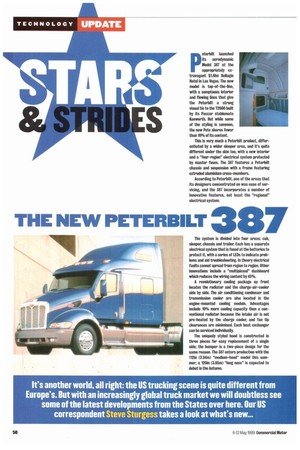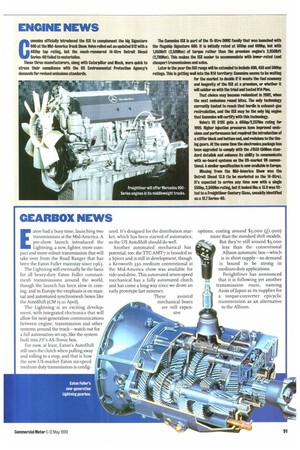THE NEW PETERB1LT 387 It's another world, all right: the
Page 52

Page 53

If you've noticed an error in this article please click here to report it so we can fix it.
US trucking scene is quite different from Europe's. But with an increasingly global truck market we will doubtless see some of the latest developments from the States over here. Our US correspondent Steve Sturgess takes a look at what's new... peterbitt launched its aerodynamic Model 387 at the appropriately extravagant $1.6bn BeHaiti° Hotel in Las Vegas. The new model is top-of-the-line, with a sumptuous interior and flowing lines that give the Peterbilt a strong visual be to the T2000 built by its Paccar stablemate Kenworth. But while some of the styling is common, the new Pete shares fewer than 10% of its content.
This is very much a Peterbilt product, differentiated by a wider sleeper area, and it's quite different under the skin too, with a new interior and a lour-region" electrical system protected by master fuses. The 387 features a Peterbilt chassis and suspension with a frame featuring extruded aluminium cross-members.
According to Peterbilt, one of the areas that its designers concentrated on was ease of servicing, and the 387 incorporates a number of innovative features, not least the "regional" electrical system.
The system is divided into four areas: cab, sleeper, chassis and trailer. Each has a separate electrical system that is fused at the batteries to protect it, with a series of LEDs to nxicate problems and aid troubleshooting. In theory electrical faults cannot spread from region to region. Other innovations include a "multiplexed" dashboard which reduces the wiring content by 45%.
A revolutionary cooling package op front locates the radiator and the charge-air-cooler side by side. The air conditioning condenser and transmission cooler are also located in the engine-mounted cooling module. Advantages include 10% more cooling capacity than a conventional radiator because the intake air is not pre-heated by the charge cooler and fan tip clearances are minimised. Each heat exchanger can be serviced individually.
The uniquely styled hood is constructed in three pieces for easy replacement of a single side; the bumper is a two-piece design for the same reason. The 387 enters production with the 1121n (2.84m) "medium-hood" model this summer, a 120i (3.05m) "tong nose" is expected to debut in the Autumn.
ENGINE NEWS
Cummins officially introduced the ISX to complement the big Signature 600 at the Mid-America Truck Show. Volvo rolled out an updated D12 with a 465hp top rating, but the much-rumoured 14-litre Detroit Diesel Series-60 failed to materialise. These three manufacturers, along with Caterpillar and Mack, were quick to stress their compliance with the US Environmental Protection Agency's demands for revised emissions standards.
The Cummins ISX is part of the 15-litre MC faindy that was launched with the flagship Signature 600. It is initially rated at 565hp and 600hp, but with 1,8501bft (2,509Nm) of torque rather than the premium engine's 2,05016ft (2,780Nm). This makes the ISX easier to accommodate with lower-rated (and cheaper) transmissions and axles.
Later lithe year the ISX range wM be extended to include 400, 450 and 500hp ratings. This' is getting well into the NU territory: Cummins seems to be waiting for the market to decide if it wants the fuel economy and longevity of the 1SX at a premium, or whether it will soldier on with the tried and tested N14 Plus..
That choice may become redundant in 2002, when the next emissions round bites. The only technology cirrently touted to reach that kr& is exhaust-gas redrculation, and the ISX may be the only big engine that Cimimins will certify with this technology.
Volvo's YE 012C gets a 465hp./2„23-illm rat* for 1999. Higher injection pressires have reproved emissions and performance but required the introduction of a stiffer block and bottom end, and revisions to the thing gears. At the same time the electronics package has been upgraded to con* with the J1939 Clitilbits standard datalink and enhance its abirty to commuricate with on-board systems on the US-market VII conventional. A similar specification is now available in Europe.
Missing from the Mid-America Show was the Detroit Diesel 13.9 (to be marketed as the 14-litre). its expected to arrive any time now with a single 550hp, 2,508Nm rating, but it looked !Pie a 13.9 was fitted to a Freightliner Century Class, sneakily identified as a 123 Series-60.
GEARBOX NEWS
Eaton had a busy time, launching two transmissions at the Mid-America. A pre-show launch introduced the Lightning, a new, lighter, more compact and more robust transmission that will take over from the Road Ranger that has been the Eaton Fuller mainstay since 1963.
The lightning will eventually be the basis for all heavy-duty Eaton Fuller constantmesh transmissions around the world, though the launch has been slow in coming, and in Europe the emphasis is on manual and automated synchromesh boxes like the AutoShift (CM 15-2.1 April).
The Lightning' is an exciting development, with integrated electronics that will allow for next-generation communications between engine, transmission and other systems around the truck—watch out for a full automation set-up, like the system built into ZE's AS-Tronic box.
For now, at least, Eaton's AutoShift still uses the clutch when pulling away and rolling to a stop, and that is how the new US-market Eaton six-speed medium duty transmission is config
ured. It's designed for the distribution market, which has been starved of automatics, so the US AutoShift should do well.
Another automated mechanical has potential. too: the TTC AMT-7 is branded as a Spicer and is still in development, though a Kenworth 330 medium conventional at the Mid-America show was available for ride-and-drive. This automated seven-speed mechanical has a fully automated clutch and has come a long way since we drove an early prototype last summer.
These assisted mechanical boxes are still expensive
options, costing around $3,000 (ft,900) more than the standard shift models. But they're still around $3,000 less than the conventional Allison automatic box—which is in short supply—so demand is hound to be strong in medium-duty applications. Freightliner has announced that it is following yet another transmission route, naming Aisin of lapan as its supplier for a torque-converter epicyclic transmission as an alternative to the Allison.












































































































